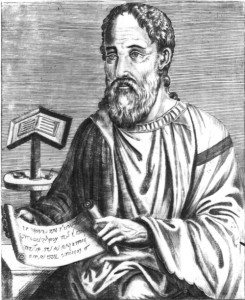We have seen how it is plausible to read Mark’s Gospel as being in fact the memoirs of Simon Peter. [See BiBloS, Issue 1, 15-17] Of the twelve disciples it is his name that appears most frequently and if we accept the ancient way of identifying sources through inclusio, by naming the speaker at both the start and end of the text, we have strong internal evidence for Petrine authorship.
As well as internal evidence from the text we can find external evidence from the historical record. Christian literature did not cease when the last apostle put down his pen for the final time although we cannot claim that these later, post apostolic, writers were inspired. To be fair, they did not claim to have received any special inspiration and as they were writing much closer to the events in question there should be no reason to doubt their integrity.
If we travel in time to the early years of the second century we meet a church leader named Papias. He lived in Asia Minor – modern Turkey – at the time when the eyewitnesses had gone and the second generation of believers – those who had known the eye-witnesses without themselves being eye-witnesses – was starting to die out. If you want a modern parallel, think of the First World War. Even at the beginning of the twenty-first century we still had a handful of eye-witnesses, who had all passed one hundred years of age before dying. We can name them: Henry Allingham, died at 112, ex-Royal Flying Corps; Harry Patch, 110, ex-army; Bill Stone, 108, ex-Royal Navy. And now even those who knew the eyewitnesses, those whose fathers and uncles fought in the Great War, are all elderly and the number of eye witnesses to the Second World War is decreasing.
Papias made it his business to collect as much material as he could while there were still people left alive who knew the eye-witnesses. (Perhaps we could call these people “ear-witnesses” because they heard from the eye-witnesses.) Unfortunately, little of Papias’s work has survived (which is bad news for us) but (good news!) a later writer, Eusebius of Caesarea, quotes him. This is what Eusebius says of Papias:
Peter’s hearers, not satisfied with a single hearing or with the unwritten teaching of the divine message, pleaded with Mark, whose Gospel we have, to leave them a written summary of the teaching given them verbally, since he was a follower of Peter. Nor did they cease until they had persuaded him and so caused the writing of what is called the Gospel according to Mark. It is said that the apostle was delighted at their enthusiasm and approved the reading of the book in the churches.
Clement quotes the story in Outlines, Book 6, and Bishop Papias confirms it. He also points out that Peter mentions Mark in his first epistle and that he composed this while in Rome, which they say he himself indicates when referring to the city figuratively in the words,
Your sister church in Babylon, chosen together with you, sends greetings; and so does my son Mark. (1 Peter 5: 13) [Eusebius, Ecclesiastical History, III. 39. 2]
Then Eusebius quotes Papias:
Mark became Peter’s interpreter and wrote down accurately, but not in order, all that he remembered of the things said and done by the Lord. For he had not heard the Lord or been one of his followers, but later, as I said, a follower of Peter. Peter used to teach as the occasion demanded , without giving systematic arrangement to the Lord’s sayings, so that Mark did not err in writing down some things just as he recalled them. For he had one overriding purpose: to omit nothing that he had heard and to make no false statements in his account. [Eusebius, Ecclesiastical History, III. 39. 15]
There is one curious detail in Mark’s gospel that is not found anywhere else. It is at Mark 14:51-52, immediately after Jesus was seized in the Garden of Gethsemane:
And a young man followed him, with nothing but a linen cloth about his body. And they seized him, but he left the linen cloth and ran away naked.
Who was this young man and what was he doing in the garden? Try as they might, no commentator can come up with any theological significance that can be drawn from this incident and surely the most plausible understanding is that this is Mark himself giving the one piece of eye-witness testimony that he saw for himself. Later writers speculated that the Upper Room was owned by Mark’s parents and that the family were therefore supporters of Jesus. When Jesus led His disciples out of the house that evening Mark, if it was indeed him, was getting ready for bed and followed behind in his night clothes.
Thus we have external evidence – from Papias early in the second century – and internal evidence from within the book itself that Mark’s Gospel was based on the eye-witness testimony of Simon Peter. We could also construct similar cases for the other three Gospels including significant eye-witness testimony. Indeed John makes his claim explicit:
This is the disciple who is bearing witness about these things and has written them down and we know that his witness is true. (John 21: 24)
I believe that there is a reasonable case to be made for believing that Matthew and Luke both knew and used Mark’s Gospel so their accounts also include much of Peter’s testimony in addition to the extra material that they had found for themselves. We can be certain that when we read Mark’s Gospel we are not getting a “once upon a time” fairy tale. Mark gives us, according to the standards of his time, a detailed and accurate biography of Jesus. He does not use footnotes or even quotation marks because he can not: they had yet to be invented.
But using the skills that he had and being guided by the Holy Spirit he gives us the very word of life or, as he says himself in his opening verse:
The Good News about Jesus the Messiah, the Son of God.
Papias of Hierapolis
Papias was active in the second century and served as a bishop in the Phrygian city of Hierapolois in what is now Turkey. Little of the works of Papias have survived although he is quoted by Eusebius among others. Papias claims to have met the Apostle John which makes him an important link between the first generation of Christians and the post-apostolic generation.
Eusebius of Caesarea
 Eusebius, a bishop of Caesarea in Roman Palestine in the fourth century A. D., was also the first Christian since Luke to attempt to write a history of the church. Luke’s church history, the document known to us as Acts of the Apostles, took the story from Jerusalem to Rome. Eusebius continued on to the point where Rome first had a Christian emperor, Constantine. Eusebius wrote a ten-volume history which is often our only surviving source for this crucial period in church history.
Eusebius, a bishop of Caesarea in Roman Palestine in the fourth century A. D., was also the first Christian since Luke to attempt to write a history of the church. Luke’s church history, the document known to us as Acts of the Apostles, took the story from Jerusalem to Rome. Eusebius continued on to the point where Rome first had a Christian emperor, Constantine. Eusebius wrote a ten-volume history which is often our only surviving source for this crucial period in church history.
Clement of Rome
Clement is named by Paul as one of his co-workers in Philippians 4:3. There were many Clements in the early church and Roman Catholic tradition names one of them as being Peter’s successor as Pope in Rome towards the end of the first century. Clement’s letter to Corinth was very highly regarded by early Christians and has survived to this day. It is readily available in, for example, Staniforth’s Early Christian Writings in the Penguin Classics series. However we cannot be certain that the Clement in Philippians is the same Clement that wrote to Corinth.
Steven Whitehead
 This article is from BiBloS, a teaching resource of the British Bible School. To read more articles or download the whole of Issue 2, click here.
This article is from BiBloS, a teaching resource of the British Bible School. To read more articles or download the whole of Issue 2, click here.

